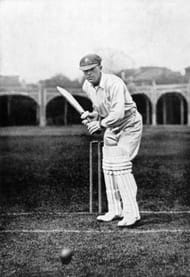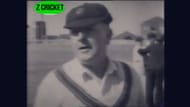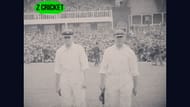
The diminutive Charles Macartney was a slow left-arm bowler before he developed into an awesome strokeplayer. Jack Fingleton explained that Macartney was known as the ‘Governor General’ because of the
“...manner in which he lorded the cricket field, entering it like one about to inspect the ranks, throwing challenges and exuding domination, dismissing bowlers from the crease as an official GG would dismiss footmen from his presence when their duty was done.”
In his first tour of England in 1909, Macartney bagged 11 wickets for 85, including 7/58 in the first innings at Leeds. It was a venue he came to revel in, as did Sir Don Bradman later, helping Australia win the Test.
When he returned to England in 1912 for the Triangular Test tournament, with South Africa as the third side, his batting prowess had already come to the fore. He rattled up six first-class hundreds, including a double century against Essex.

Charles Macartney at peak of his career
After the war, Macartney came into his own as a batsman. Neville Cardus observed:
“He was less courtly in his stroke-play than (Victor) Trumper, whose masterful innings had a certain effortless charm. Macartney, perfect of technique, none the less used his bat with an unmistakable pugnacity. Sir Donald Bradman annihilated all bowlers as though he was just performing the day’s work with a deadly efficiency. Macartney slaughtered bowling quite rapaciously.”
Cardus further stated, while narrating an anecdote,
“Macartney employed a defensive stroke as a last resort. Nothing could daunt him. Before the start of a Lord’s Test match, he came down to breakfast in a London hotel, looking through the window at the June sunshine and said: ‘Lovely day, Cripes, I feel sorry for any poor cove who’s got to bowl at me today’.”
It was at Sydney that Macartney made his highest Test score of 170 against England in 1920-21, when a young boy named Don Bradman was an avid spectator. Soon thereafter, in the English summer of 1921, his 115 helped Warwick Armstrong’s famous side win the Leeds Test.

But his most enthralling, and highest, innings came against Nottinghamshire during that tour. In it, he crashed 345 in less than four hours with 47 fours and 4 sixes.
It was the highest score for any Australian batsman touring England. It was also the maximum runs scored in a day until 1994. The record was broken by Brian Lara who scored 390 on his way to a record-shattering 501* for Warwickshire against Durham at Birmingham.
Charles Macartney's 100 before Lunch vs England
When Macartney visited Leeds again during his fourth tour of England, in 1926, he scored another memorable century. Ken Piesse described that brilliant innings thus:
“Although the wicket was damp from the heavy overnight rain, the sun had not come out, saving the Australians from the dreaded ‘sticky’. Without the sunshine, (Arthur) Carr’s bowlers were not able to make the ball jump or twist, making batting a not-so-difficult duty.”
Nevertheless, Maurice Tate had Warren Bardsley, captain in the absence of Herbie Collins, caught by Herbert Sutcliffe with the scoreboard still blank. Macartney walked in, and being the kind of player he was, offered an early chance.
When he was on 2, Macartney flashed at Maurice Tate’s out-swinger, but Carr dropped him at third slip.
From then on there was no stopping Macartney. He wrote in his book My Cricketing Days:
“I made up my mind to attack and kept on attacking. I felt like it and, as a result, I went for everything.”

He reached his century before lunch, emulating the singular feat of Trumper, which was replicated by Bradman!
At the interval, Macartney was on 112, his partner Bill Woodfull 40, and Australia had 153 on the board. Macartney ultimately holed out to deep mid-off for 151, having cracked 21 boundaries in just 172 minutes. His second-wicket stand of 235 with Woodfull was a record.
That was his last Test series, in which he scored 3 hundreds, the others being 133* at Lord’s and 109 at Manchester. He passed on the baton to a lad named Donald George Bradman, who was to make his appearance in the very next rubber that Australia played.
In 35 Tests, Charles Macartney aggregated 2,131 runs at an average of 41.78. Peter Hartland noted,
“For Macartney, dominating the bowler was just as important as making a big score, and he loved to whip straight balls through the leg side. In many ways he was the nearest of old-timers to Vivian Richards.”
(Excerpt from Indra Vikram Singh’s book ‘Don’s Century’).
Follow IPL Auction 2025 Live Updates, News & Biddings at Sportskeeda. Get the fastest updates on Mega-Auction and cricket news
